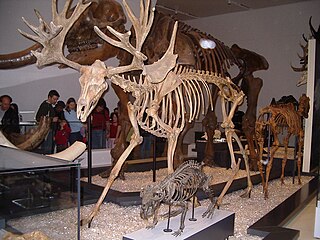
Phacops is a genus of trilobites in the order Phacopida, family Phacopidae, that lived in Europe, northwestern Africa, North and South America and China from the Late Ordovician until the very end of the Devonian, with a broader time range described from the Late Ordovician. It was a rounded animal, with a globose head and large eyes, and probably fed on detritus. Phacops is often found rolled up, a biological defense mechanism that is widespread among smaller trilobites but further perfected in this genus.

The southern hairy-nosed wombat is one of three extant species of wombats. It is found in scattered areas of semiarid scrub and mallee from the eastern Nullarbor Plain to the New South Wales border area. It is the smallest of all three wombat species. The young often do not survive dry seasons. It is the state animal of South Australia.

Bison latifrons is an extinct species of bison that lived in North America during the Pleistocene epoch. B. latifrons thrived in North America for approximately 200,000 years, but became extinct some 20,000–30,000 years ago, at the beginning of the Last Glacial Maximum.
The Pacific fat sleeper is a species of fish in the family Eleotridae found on the Pacific coast of the Americas from around Palos Verdes, California, to Peru, where it can be found in stagnant or sluggish fresh or brackish waters or nearby marine waters. Males of this species can reach a length of 41 cm (16 in), while females grow to 39 cm (15 in). Most do not exceed 25 cm (9.8 in). A maximum weight of 1.2 kg (2.6 lb) has been recorded. This species is important to local commercial fisheries and is actively farmed.
Amietophrynus latifrons is a species of toad in the family Bufonidae. It is found in Cameroon, Republic of the Congo, Democratic Republic of the Congo, Equatorial Guinea, Gabon, possibly Angola, and possibly Nigeria. Its natural habitats are subtropical or tropical moist lowland forests and subtropical or tropical moist montane forests. It is threatened by habitat loss.
Phrynobatrachus latifrons is a species of frog in the Phrynobatrachidae family. It is found in the West Africa from Senegal to northern Cameroon.

The white-fronted falconet, Bornean falconet, fauconnet de Bornéo, falconete de Borneo, or halconcito de Borneo is a species of bird of prey in the family Falconidae. It is endemic to Sabah on the island of Borneo. Its natural habitats are subtropical or tropical moist lowland forest and arable land. It is threatened by habitat loss.

Mugilogobius latifrons is a species of goby endemic to the Malili Lake system in central Sulawesi, Indonesia generally being found in extremely shallow waters. This species can reach a length of 4.7 centimetres (1.9 in) TL.
Calliphora latifrons is a species of blue bottle fly.
Mirosternus latifrons is a species of beetle in the family Ptinidae.
Terpnomyia latifrons is a species of ulidiid or picture-winged fly in the genus Terpnomyia of the family Ulidiidae.
Maiestas latifrons, formerly Recilia latifrons, is a species of bug from the Cicadellidae family that can be found in countries such as China, Japan, Korea, and the Russian maritime. It can be found on and feeds on rice plants.

Cervalces latifrons, the broad-fronted moose, was a large, moose-like deer of the holarctic regions of Europe and Asia dating from the Pleistocene epoch. It is believed to be the largest species of deer that ever existed, larger than its North American relative Cervalces scotti, Megaloceros, and the modern moose. This species is believed to have become extinct around 10,000 years ago.

Cervalces is an extinct deer genus that lived during the Pliocene and Pleistocene epochs. Cervalces gallicus, the ancestral species, lived in Europe from the Pliocene to the Pleistocene strata. Cervalces scotti, the stag-moose, lived in Pleistocene North America. Cervalces latifrons, the broad-fronted moose, and Cervalces carnutorum were found in Pleistocene Europe and Asia.

Proetus is a genus of proetid trilobite found in Silurian-aged marine strata of Europe.
The blacktip poacher is a fish in the family Agonidae (poachers). It was described by Charles Henry Gilbert in 1890. It is a marine, deep water-dwelling fish which is known from British Columbia, Canada to Baja California, Mexico, in the eastern Pacific Ocean. It dwells at a depth range of 18–400 metres, and inhabits soft benthic sediments. Males can reach a maximum total length of 19 centimetres.

Encephalartos latifrons is a species of cycad that is native to Eastern Cape province in South Africa at elevations of 200 and 600 meters.
Sobarocephala latifrons is a species of flies in the family Clusiidae.
Microcentrum latifrons, the southwestern angle-wing katydid, is a species of phaneropterine katydid in the family Tettigoniidae. It is found in North America.
The Coquito sergeant, also knowns as the Coquito damsel, is a species of ray-finned fish, it is the only species in the monotypic genus Nexilosus which is classified in the family, Pomacentridae, the clownfishes and damselfishes. It is found on rocky coasts in the eastern Pacific Ocean off Peru and northern Chile, as well as the Galapagos Islands.










